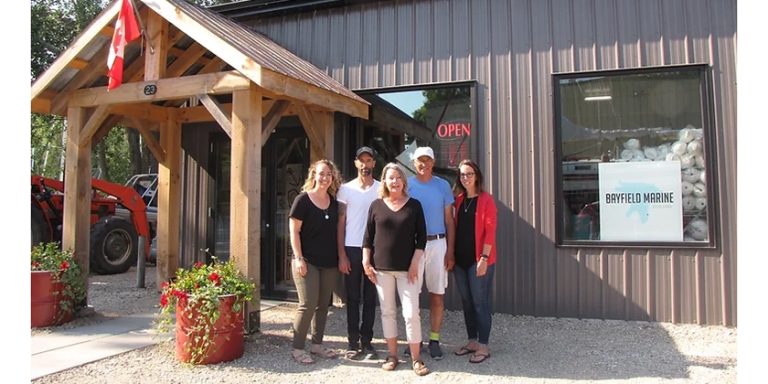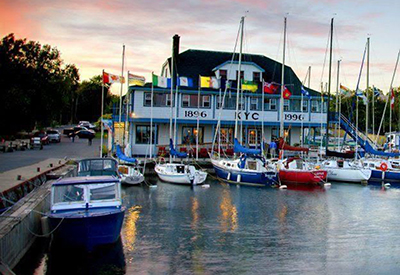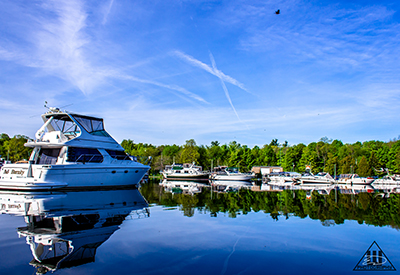LaHave River Yacht Club
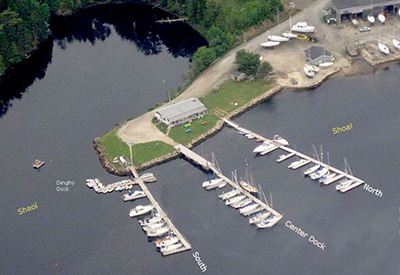
Oct 26, 2017
This brief history of the early days of the LaHave River Yacht Club (LRYC) gives an idea of the DIY enthusiasm of the club’s founders and the unpretentious love of boating motivated them.
The LaHave River Yacht Club is located on the West side of the LaHave River, 12 kilometers south of the town of Bridgewater. Founded with 50 members who held their early get-togethers at the old Drill Hall in Bridgewater, since many of them were also in the Reserves. The first slate of officers was: Commodore – Ed Goudey, Vice Commodore – Fred Surbeck, Rear Commodore – Captain Malcolm Wilkie, Treasurer – Macgregor Miller, Secretary – Victor Killam.
The first boats in use at the club were mostly fishing boats that had been converted to pleasure crafts – quite a motley fleet. The site for the clubhouse was chosen because it possessed an excellent wharf where Captain Wilkie kept his three-masted schooner and it had access by a public road. The land was leased for $10.00 a year from Mr. Josiah Pernette.
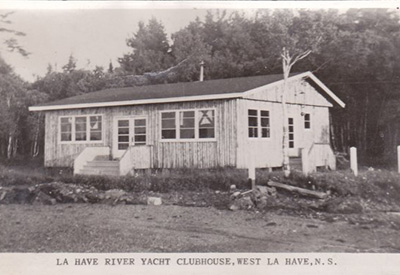
Construction began in the spring of 1949 – about the same time the yacht club was incorporated in the Nova Scotia legislature by Chapter 102 of the Acts of Nova Scotia. Built of split-log siding supplied by the Caledonia Hardwood Company and 2,000 square feet of red pine given at half price by Macgregor Miller from his family lumber yard, the clubhouse was designed by the members and the master builder was Angus Ernst, assisted by Stanford Baker, Melvin Schnare and Thomas Haughn. Mr. Charles Wentzell represented the Club in overseeing the project as he was quite “mechanically minded”. Mr. Ernst received a salary of 90 cents an hour, Mr. Baker – 65 cents an hour, with Mr. Schnare and Mr. Haughn each receiving 55 cents an hour.
 A canteen was started almost immediately after the clubhouses was completed, although a well was not drilled until July of 1952. This work was done by the Bluenose Well Drilling Company Limited, of Bridgewater. The yearly dues were $5.00 for senior members and $2.00 for junior members. By 1952 dances were being held in the clubhouse every Saturday night, with the first dance on June 14th. Members held annual cruises with destinations such as Deep Cove and Chester, and they were soon hosts to annual cruises from the Armdale Yacht Club. A racing schedule was begun with Predicted Log Cruises, which were popular at the time. Each skipper had to predict how long it would take him to travel the course. Watches were not allowed except on compass courses, while charts could be used except on the compass course. Each cruise was divided into two legs with the second leg orders being sealed and only opened after the first was completed, with each boat carrying a scrutinizer. The earliest trophy was the Bulletin Trophy.
A canteen was started almost immediately after the clubhouses was completed, although a well was not drilled until July of 1952. This work was done by the Bluenose Well Drilling Company Limited, of Bridgewater. The yearly dues were $5.00 for senior members and $2.00 for junior members. By 1952 dances were being held in the clubhouse every Saturday night, with the first dance on June 14th. Members held annual cruises with destinations such as Deep Cove and Chester, and they were soon hosts to annual cruises from the Armdale Yacht Club. A racing schedule was begun with Predicted Log Cruises, which were popular at the time. Each skipper had to predict how long it would take him to travel the course. Watches were not allowed except on compass courses, while charts could be used except on the compass course. Each cruise was divided into two legs with the second leg orders being sealed and only opened after the first was completed, with each boat carrying a scrutinizer. The earliest trophy was the Bulletin Trophy.
A club burgee was designed – a royal blue pennant with a white stripe running through the center and a red cairn surmounted on the white field. The cairn represented the cairn located at Fort Point. The Nova Scotia flag was chosen as the Club ensign. The first flagpole and staff was donated by Mr. Teddy Snyder and Captain A. S. Publicover. The marine railway was constructed in 1955 and the rock wall was enlarged. By 1958 all remaining bonds were redeemed and the Bond Redemption Account was closed. An outboard motor division of the Club was established with the Club open for gas sales on Wednesdays from 1 to 3pm, and Saturday and Sundays from 7 to 9pm. If members required gasoline at other times, they contacted the Commodore or the Treasurer. A slipway for small boats was erected at the lower edge of the clubhouse with a barrier placed to mark off deep water. By 1960 many improvements were made to the house and grounds. A space heater was acquired, as well as picnic tables and garden chairs. There were now two slips and finally, a floating wharf with crib and cat walk. Unfortunately, this resulted in a mishap on one dance evening when several enthusiastic members decided to do the ‘bunny-hop’ down the floating wharf, overloading it and depositing the ladies in long dresses and gentlemen in suits into the water!
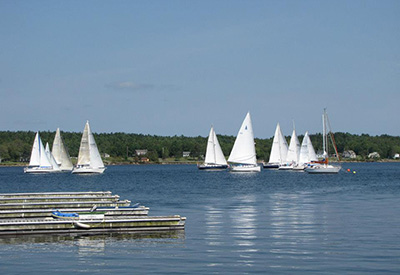
In 1956 the first LRYC Sailing Trophy ever won in competition was earned by Mr. Gerald Stevens of Chester, who at the time was sailing under the colors of the LaHave River Yacht Club at the Lunenburg Regatta.
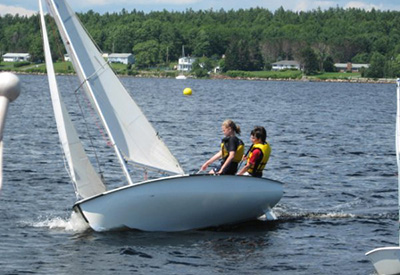 Land for the present site was made available at a minimal cost by Mr. and Mrs. Chris Couthard and with the generous financial assistance of fifteen present and former club members. In 1972 Dr. Mike Delory arranged through Mr. Jim Kinley for a LIP grant to move the building across the cove on the ice, to its present location. The move was not without mishap as much damage occurred when pulling the building up the bank. Land not needed for the Club, boat yard and cradle yard was subdivided and lots sold to raise money for club enlargement and site development. The boat house and sheds were designed and engineered by Mr. Ralph Richards and Mr. Arthur Dechman. These were built privately with donated materials and contributed labour. The marine railway was constructed in 1972 and the main wharf in 1973. In the years since then many other improvements have been added.
Land for the present site was made available at a minimal cost by Mr. and Mrs. Chris Couthard and with the generous financial assistance of fifteen present and former club members. In 1972 Dr. Mike Delory arranged through Mr. Jim Kinley for a LIP grant to move the building across the cove on the ice, to its present location. The move was not without mishap as much damage occurred when pulling the building up the bank. Land not needed for the Club, boat yard and cradle yard was subdivided and lots sold to raise money for club enlargement and site development. The boat house and sheds were designed and engineered by Mr. Ralph Richards and Mr. Arthur Dechman. These were built privately with donated materials and contributed labour. The marine railway was constructed in 1972 and the main wharf in 1973. In the years since then many other improvements have been added.
Ewart Morse, LRYC Historian
Today visitors are welcomed with moorings available for $23 per night and docks for $23. For more information visit www.lryc.ca
photos courtesy of LRYC


